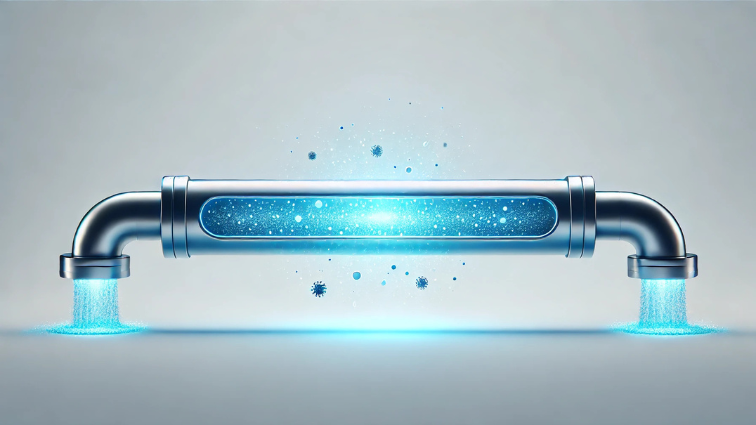Why is legionella prevention important?
Legionella are bacteria that thrive particularly well in warm water and can be inhaled via aerosols. They cause dangerous legionellosis (Legionnaires' disease). Hot water systems in residential buildings, hotels, hospitals or industrial plants are particularly susceptible. A proven method of prevention is UVC disinfection, which works without chemical additives and enables continuous water disinfection.
How does UVC disinfection against legionella work?
UVC technology uses ultraviolet light with a wavelength of approx. 254 nm to destroy the DNA and RNA of legionella bacteria. As a result, the bacteria lose their ability to reproduce and are rendered harmless. The UVC unit is installed in the hot water circulation system and irradiates the flowing water so that it remains germ-free.
Challenges and opportunities of UVC disinfection in hot water systems
The challenges
- Circulation systems provide a breeding ground for biofilms in poorly flowing pipe sections. UVC only irradiates the flowing water, but not adhering biofilms.
- Irradiation duration should be sufficiently long. A correctly dimensioned UVC system is crucial for killing efficiency.
- Regular maintenance is essential, as the lamp output decreases over time and must be replaced in good time.
Opportunities
- Chemical-free disinfection is free of harmful by-products and chloramines.
- Immediate effect prevents legionella from multiplying directly on contact with the radiation.
- Sustainable solution only requires electrical energy for lamp operation; no costs for chemicals.
Comparison with other methods
Thermal disinfection
Heating the water to at least 70 °C kills legionella.
- Advantages: Immediate killing of germs at a sufficient temperature, no additional devices if the system is suitable.
- Disadvantages: High energy requirement, possible material damage due to high temperatures, no lasting effect as legionella can grow again after cooling down.
Chemical disinfection (chlorination, chlorine dioxide, hydrogen peroxide)
Disinfectants that flow through the system are used to kill the bacteria.
- Advantages: Also captures biofilms in the pipes, long-term depot effect possible.
- Disadvantages: Risk of harmful by-products, changes in taste and odor of the water, higher maintenance effort for control and dosing.
Conclusion
UVC disinfection is an efficient, chemical-free and environmentally friendly method of reducing legionella in hot water systems. It is particularly effective in systems with a good flow rate, but only reaches adhering biofilms to a limited extent. A combination with thermal or chemical processes enables comprehensive legionella prevention. UVC is a promising alternative to conventional methods for energy-efficient buildings and sustainable water treatment systems.
 Phone: +49 3641 327 9697
Phone: +49 3641 327 9697
 Official Purion dealer
Official Purion dealer

